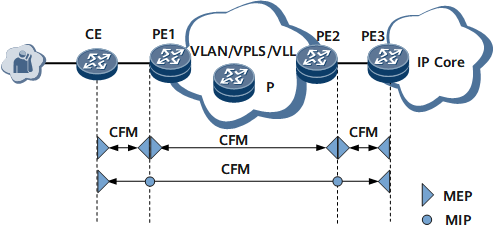Configuring Basic CFM Functions
This section describes how to configure basic connectivity fault management (CFM) functions.
Usage Scenario
IP-layer mechanisms, such as IP ping and traceroute, are used to manage network-wide services, detect faults, and monitor performance on traditional Ethernet networks. These mechanisms are not effective for Ethernet operation and management.
Both interfaces of the direct link between the CE and PE1 are Layer 2 interfaces.
A Layer 2 network is deployed between the CE and PE2.
A Layer 2 network is connected to a Layer 3 network through PE3.
Pre-configuration Tasks
Group the devices of each Internet service provider (ISP) into a maintenance domain (MD).
Specify the name and level of the MD and configure the same MD name and level on the devices in the MD.
Specify maintenance associations (MAs) for the MD based on service types, such as VLAN, VPLS and VLL.
Specify each MA's name and configure the same MA name on the devices in the MD.
Specify maintenance association end points (MEPs) and maintenance association intermediate points (MIPs) for each MA in the MD.
- Enabling CFM Globally
- This section describes how to globally enable connectivity fault management (CFM).
- (Optional) Switching CFM Versions
- This section describes how to switch between connectivity fault management (CFM) versions.
- Creating an MD
- This section describes how to create a maintenance domain (MD).
- Creating an MA
- This section describes how to create a maintenance association (MA).
- Creating MEPs
- This section describes how to create maintenance association end points (MEPs).
- (Optional) Creating a MIP
- This section describes how to create a maintenance association intermediate point (MIP).
- (Optional) Switching MAC Address Models for MPs
- This section describes how to switch Media Access Control (MAC) address models for maintenance points (MPs).
- Configuring CC
- This section describes how to configure continuity check (CC) in an L2TPv3 scenario.
- Verifying the Basic CFM Function Configuration
- After configuring basic connectivity fault management (CFM) functions, verify the configurations.
